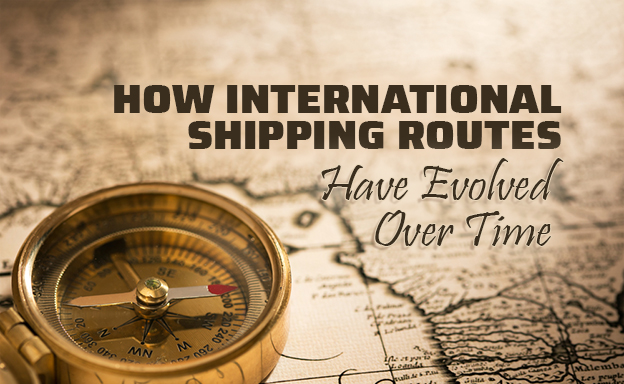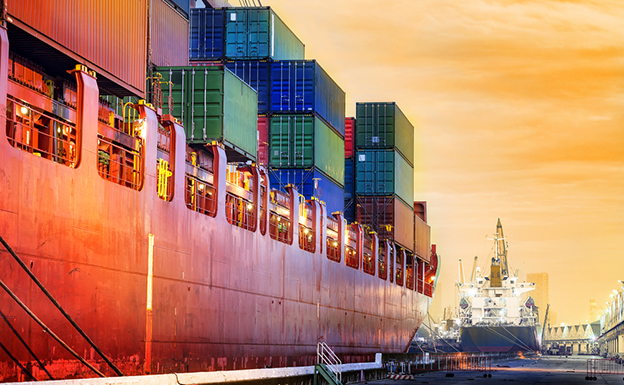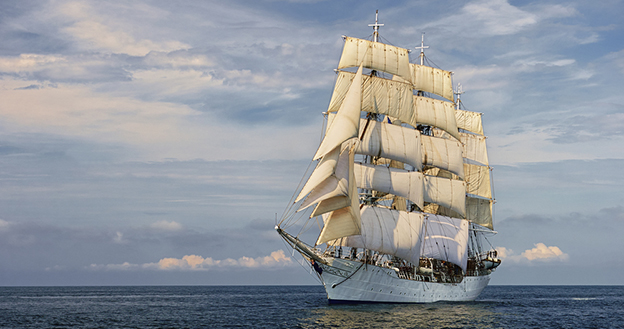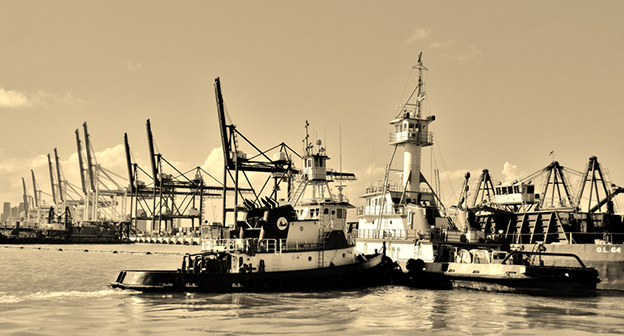
International shipping has become a fundamental part of the global economy, but in centuries past, moving items from one country to another was a Herculean task. From domesticated camels to sailing vessels and eventually the birth of air freight shipping, international trade routes have changed dramatically over the course of human history. Take a peek at how these routes were created and what they look like today.
THE SILK ROAD AND EAST VS. WEST
During ancient times, there were no nations, so the term “international trade” didn’t really apply. Civilizations and colonies throughout Europe, the Middle East and China were trading goods across relatively short distances, using vessels to transport goods across the Red Sea, what was known as the Erythraean Sea, now known as the Arabian Sea, and the Mediterranean. Considering the labor and resources required to transport goods and people, goods were only traded out of necessity. Some items such as tea, incense, herbs, wool, silver and gold could only be found in certain regions of the world. Traders and merchants discovered they could make a profit by dominating local trade routes and importing these rare goods into the local market.
But as time went on, the world was shaped by two growing empires–the Roman Empire and China. As these two world powers came into existence, the idea of trading between the two proved too valuable to resist. This led to the creation of the world’s most legendary trade route, the Silk Road, around 200 BCE, which continued to evolve over the next 600 years. Not a single route at all, but rather a term used to describe the many routes used to move goods back and forth between the two empires. Merchants from China were mostly selling silk, widely considered a valuable commodity throughout the Roman Empire and the European continent. European merchants were trading wool, silver and gold with their Asian counterparts.
The Silk Road was nearly 4,000 miles during this time and it was rare for a single merchant to make the entire trek themselves. There were many trading centers along the Silk Road, including Samarkand, which is now the country of Uzbekistan. The route was closely connected to the Great Wall in China, which provided the infrastructure necessary to move goods across such long distances. Goods would then pass through the Pamir Mountains and down into modern-day Afghanistan and through Iran and Iraq. They were then loaded onto ships at the edge of the Mediterranean on the shores of modern-day Syria, Lebanon and Israel.
However, the Silk Road wasn’t just about trading physical goods. It became a way of trading cultures, ideas, religion and culture. Having little knowledge of this new civilization, both parties were insatiably curious about how the rest of the world lived. This led to the rise of long-distance trading and a more interconnected global society. It also led to the spread of bacteria, infecting new population centers and leading to the rise of the Black Death.
SPICES AND THE RISE OF MARITIME TRADE ROUTES
After the fall of the Roman Empire, Europe evolved into a series of nation states, including the growing British Empire. New technology in the form of mighty sailing vessels with improved navigation allowed merchants to explore new territories across the globe. This was the first time in history that European settlers could sail around the world, forging new trading partnerships with China, India and Japan. Ships would sail down and around the southern tip of Africa to reach these Eastern markets, again trading goods like silver, gold, wool and silk.
During what was known as the Age of Exploration during the 15th, 16th and 17th centuries, this new technology also led to the colonization of new continents and islands all over the world, including the East Indies, now Indonesia, and what were known as the Spice Islands, a large archipelago near New Guinea, now known as the Maluku Islands. British explorers made a fantastic discovery during this time: nutmeg and spice cloves. The British Empire took control of the islands, dominating the global market for these new spices. Society grew infatuated with these new flavors. In fact, Christopher Columbus set sail for the Americas partly in search of new spices.
Towards the end of the Age of Exploration, the British also took control of Bombay Island, off the coast of India, eventually commandeering the entire country. With fast access to Asian markets and Europe, this was the perfect spot for the British Empire to launch the English East India Company, a vast trading empire that would encompass nearly half of all global trade. The Dutch also became leaders in international trade with their vast fleet of vessels and the rise of Amsterdam as one of the largest trading ports in the world. The Dutch created their own trading venture, the Dutch East India Company, which relied heavily on a route between Amsterdam and Southeast Asia. If anyone was capitalizing off these new trade routes, it was the British and the Dutch.
Again, the world was slowly becoming more interconnected, thanks to the discovery of maritime vessels. New civilizations were created and fought over during this time. New diplomatic relations were taking root between Asia and Europe as countries became increasingly dependent on the free movement of goods.
THE INDUSTRIAL REVOLUTION AND PRE-WAR TRADE ROUTES
The spread of free trade and maritime technology eventually led to the dissolution of the Dutch East India Company as new competitors entered the fray. American independence created new trading routes across the Atlantic as the U.S. became another major player in international trade. America saw how Britain had amassed a wealth of influence and power on the world stage thanks to its aggressive trade expansion. This new nation was looking to do the same. But in the years after the American Revolution, the country was still largely dependent on the British in terms of importing goods from China and the rest of the international community. Yet, American demand was growing for Chinese goods such as silk, tea and porcelain.
Over the course of the 19th Century, America slowly expanded its trading capabilities. The ports of Boston, Salem, New York and Philadelphia began launching vessels across the Atlantic, around the southern tip of Africa, and across the Indian Ocean to China, India, and Japan. But America also had to figure out what they had to offer Chinese merchants in exchange for their goods as opposed to simply buying goods with coins and precious medals. America began exporting furs and ginseng, but these commodities proved unsustainable, putting the U.S. at a disadvantage.
During this time, many nations became accustomed to exporting the goods they could produce domestically and importing everything else they needed. This is known as inter-industry trade where countries would typically export two or three goods they had in abundance, while depending on the imports of other nations from around the world. With limited exports, countries required fewer trade routes. This represents a stark difference from the way international trade is practiced today. In modern society, most countries import and export products they produce domestically, which dramatically increases the volume of international trade.
Overall, industrialization and growing demand for international goods led to a consistent rise in international trade over much of the 19th Century and up until the First World War. In fact, up until 1913 and the start of the war, international trade grew by 3 percent annually. This represents what became known as the first wave of globalization, in which new nations were being formed and diplomatic relations became a fundamental part of society.
INTER-WAR NATIONALISM AND THE DECLINE OF INTERNATIONAL TRADE
World War I led to a rise of nationalism and protectionism across North America and Europe as the continent became embroiled in a tense military conflict. International trade quickly plummeted throughout the Western World during the inter-war period. The U.S. imposed stiff tariffs during the inter-war period as a way of giving a boost to domestic production. Yet, these tariffs eventually led to the Great Depression and economic instability throughout the Western World.
With international trade plummeting during these years, few new trade routes were established. From 1929 to 1932, world imports and exports among the industrialized nations dropped by around 30 percent. The world would need another major international conflict to reenergize the global economy and the volume of international trade.
WWII AND THE SECOND WAVE OF GLOBALIZATION
In the aftermath of the Second World War, the U.S. and its allies enacted some of the most successful trade policies in history, many of which are still in effect today, including the North American Free Trade Agreement or NAFTA. This policy alone dramatically increased trade between Canada, the U.S. and Mexico, as large rail companies and the trucking industry began moving goods over international borders. This post-war period became known as the second wave of globalization, marked by a sudden increase in international trade.
The second wave of globalization ushered in a new period of intra-industry trade, in which countries began importing and exporting similar goods, including those they produced domestically. This sharply increased international trade as countries started enjoying a wider range of goods, including those produced in multiple countries. The U.S. started exploring new trade markets, including those in South America, which sent vessels south to the nations of Argentina, Chile and Brazil.
Air freight shipping slowly took off during the 1920s and ’30s as airlines began converting some of their planes into cargo carriers. While the main form of international trade was and continues to be ocean freight, air freight became the number one choice for shipping goods around the globe on a tight deadline. This dramatically opened new trade routes for the U.S. and its trading partners abroad as shippers no longer had to rely on the open seas and specific routes. Planes could arrive in another country in a matter of hours.
The World Trade Organization was also developed in 1995 as a way of managing and resolving disputes related to international trade. This organization has helped promote and facilitate new trading partnerships all over the world.
MODERN TRADE ROUTES AND THE GLOBAL SUPPLY CHAIN
Today, international trade is at an all-time high with the U.S., the European Union and China being the largest importers and exporters in the world. The price of international shipping has come down considerably in the last several decades, helping smaller businesses and manufacturers move their products around their world with little effort. The global supply chain is made up of a vast network of trucks, railways, airlines and ocean freights, moving goods in all different directions at any given time. Shipping companies have grown considerably, reducing the price of their services to increase their share of clients. These companies use logistics to plan, coordinate and modify trade routes in real-time to ensure a timely delivery for their clients.

Improvements in ocean freight shipping now allow for larger shipments, which may take more time to arrive at their destination. This has led to new imports and exports, including automobiles, large pieces of industrial equipment and other massive items that would have been difficult to ship in years past. Smaller shipments can fly all over the world in a matter of hours using air freight shipping, now an integral part of the global supply chain. The advancement of air freight shipping has led to a rapid increase in the number of international trade routes as planes are free to fly in every direction.
The birth of the internet and online shopping has contributed greatly to international shipping. Consumers are free to purchase goods from all over the world with the touch of a button. This allows businesses to enter the international trade market with few barriers. Consumers have come to depend on the variety of goods they can purchase online, giving little thought to the item’s origin or the route it will take to arrive at its destination.
The world has come a long way since the days of the Silk Road. Improvements in transportation and navigation have largely contributed to the rise of international trade, allowing countries to explore new trade routes and forge new diplomatic partnerships. The creation of the internet and air freight shipping have had some of the largest effects on international trade routes, with goods moving across international borders in a matter of hours.





